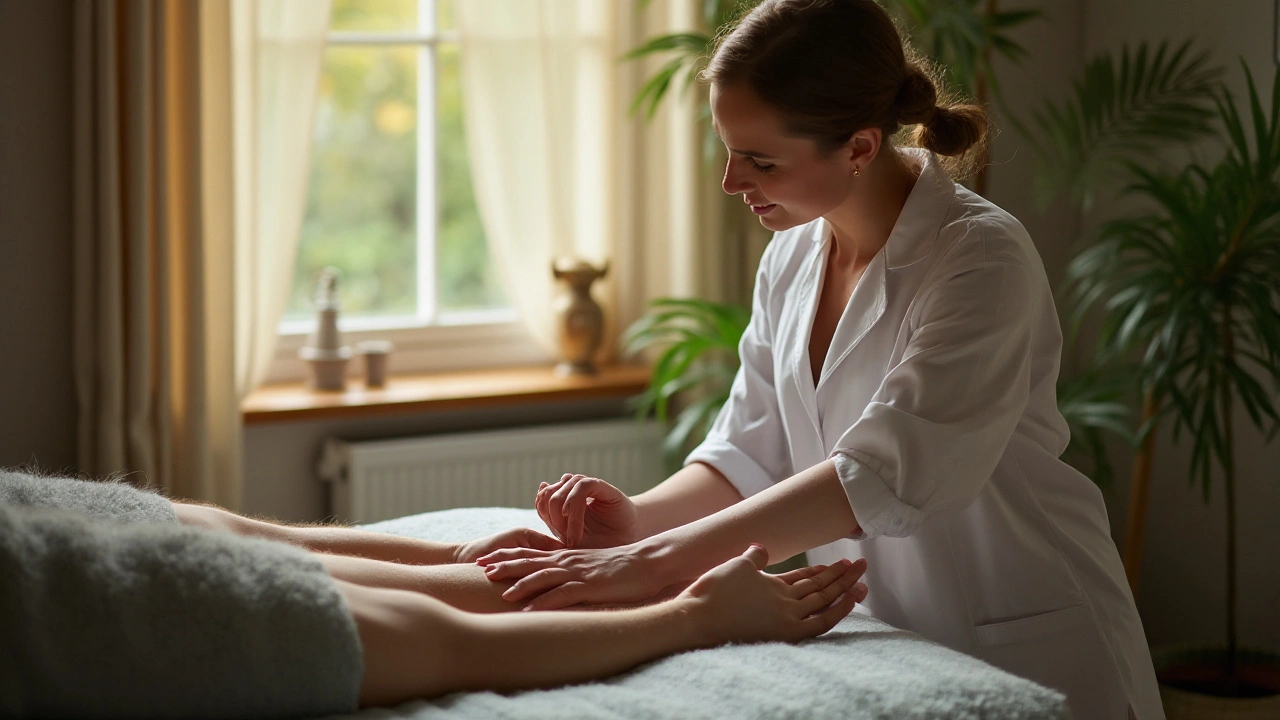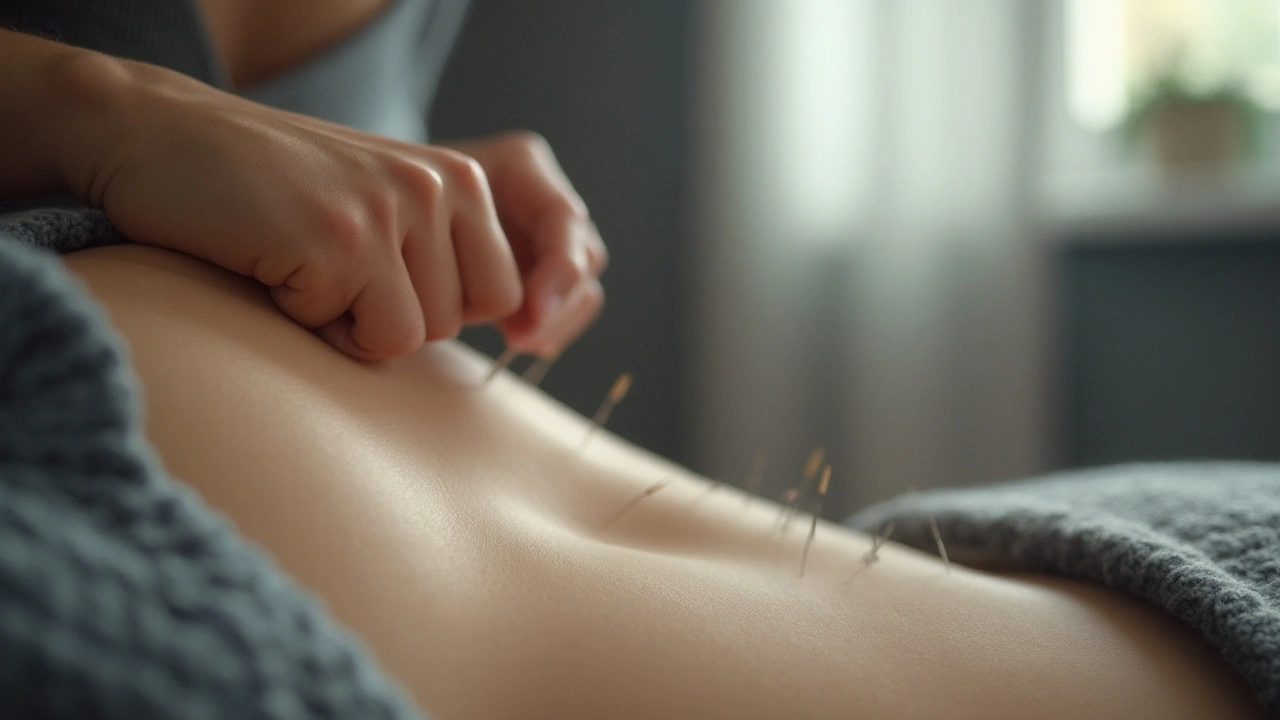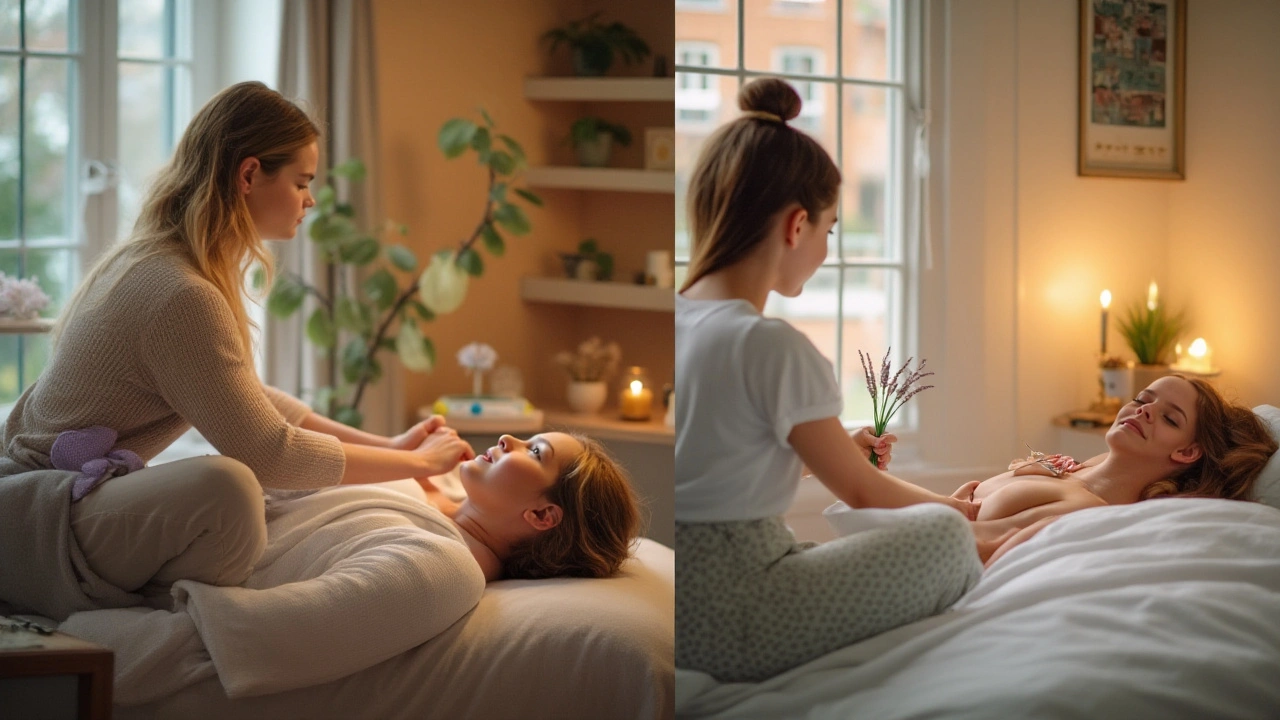Understanding Acupressure and Acupuncture: Key Differences Explained
 Jan, 14 2025
Jan, 14 2025
In the realm of alternative therapies, acupressure and acupuncture stand out for their unique approaches to promoting health and wellness. They both trace their roots back thousands of years to ancient practices aimed at balancing the body's energy flow, known as 'Qi'. However, while their goals may align, the paths they take to achieve these results differ significantly.
Acupressure involves applying physical pressure to specific points on the body, often referred to as pressure points, to alleviate stress, tension, and other ailments. It is a non-invasive therapy that can be easily done by oneself or with the help of a practitioner. On the other hand, acupuncture requires the insertion of fine needles into specific bodily points, a practice that typically necessitates a trained acupuncturist.
Each method carries its own set of benefits and is suitable for different individuals based on their comfort with needles and the level of expertise available. Whether it's for managing chronic pain or seeking emotional balance, understanding the intricacies of each can help in making an informed decision on which might be more beneficial.
- Introduction to Acupressure and Acupuncture
- Historical Origins
- Techniques and Methodologies
- Benefits and Uses
- Safety and Comfort
- Choosing the Right Practice
Introduction to Acupressure and Acupuncture
When we talk about ancient healing arts, acupressure and acupuncture often surface as intriguing topics of discussion. These practices, rooted deeply in traditional Chinese medicine, have been employed for centuries to address various physical and psychological conditions. While both are grounded in the philosophy of balancing the body's energy, known as Qi, they diverge in methodology. The essence of acupressure lies in applying firm, gentle pressure on specific points along the body's meridians. These meridians, essentially invisible pathways encasing our body, are believed to be conduits for vital energy. By stimulating these points with the fingertips or knuckles, acupressure aims to encourage the natural healing processes of the body.
Conversely, acupuncture uses ultra-fine needles inserted into the skin at precise points. This practice extends beyond mere pressure; with accuracy, it is said to unleash energy blockages and restore harmony within. For many, the idea of needles might be disconcerting, but in skilled hands, this ancient art has a reputation for being relatively painless. It's fascinating to note that while both therapies may sound drastically different, they hold similar fundamental beliefs about the flow of energy and its influence on health. Often dubbed as 'miracle workers' of pain relief and stress reduction, acupuncture and acupressure have earned respect in the modern wellness landscape.
Discussion around these methods often piques the interest of those seeking alternative pathways to health, especially in a world leaning increasingly on pharmaceuticals. According to a study documented in the Journal of Pain Management, individuals treated with acupuncture reported a significant decrease in chronic pain levels compared to those who relied solely on conventional medicines. On the topic, Dr. Lin, a leading figure in the field, once remarked,
"Acupressure can be self-administered for minor ailments, making it accessible to more people, whereas acupuncture requires precision from a trained professional but can achieve deep therapeutic effects."To delve deeper into these practices is to unravel a world where ancient wisdom intertwines with modern science, opening up possibilities for relief and regeneration without invasive procedures or chemical interventions.
Historical Origins
The rich and intriguing histories of acupressure and acupuncture trace back thousands of years, deeply intertwined with the philosophies of ancient Chinese medicine. The origins lie in the belief in Qi, the life energy that flows through the body’s meridians. Maintaining the balance of this energy was seen as the key to both physical and spiritual well-being. This understanding, documented as early as the Huang Di Nei Jing or The Yellow Emperor's Classic of Internal Medicine, set the groundwork for practices that would evolve over the centuries.
The traditional Chinese concept of meridians, not visible to the naked eye, was essential to mapping the body and determining where acupressure and acupuncture points existed. Acupressure likely emerged as a precursor to acupuncture, as no tools were needed other than the practitioner’s hands. It appealed as a natural, hands-on healing method, accessible to many. Perhaps it was practiced as early as the Neolithic era, when rudimentary tools would eventually pave the way for the sophisticated needles used in acupuncture.
The first documented use of acupuncture needles dates back to around 100 BCE. Traditional materials like bones and stones eventually evolved into metal needles, showcasing the advancement of this practice. As trade routes expanded, so did the dissemination of these practices. By the time of the Tang Dynasty (618–907), not only had acupuncture and acupressure been refined, but they had also spread beyond China into neighboring regions and, eventually, to the Western world.
In Japan, the adoption of acupuncture was complemented by the development of Shiatsu during the 20th century—a technique that mirrors acupressure’s essence, focusing heavily on finger pressure at specific points. One of the fascinating developments during acupuncture's journey westward was the organization of these practices into regulated systems of health care. This led to increased research and evidence-based studies which piqued curiosity even among medical professionals.
According to Dr. Lisa Raphals, a scholar in Chinese medicine, "The art of acupuncture remains deeply rooted in history and philosophy, yet it has adapted remarkably to the times, integrating modern medical practices while still adhering to its ancient principles."
Both acupressure and acupuncture have seen various interpretations and adaptations across different cultures. This cross-cultural evolution shows their endurance and relevance across centuries. Their history is not just a tale of traditional medicine but also a testament to the unyielding human quest for holistic healing. Today, as more people seek alternative therapies, these practices continue to offer insight into an intricately intertwined system of mind, body, and spiritual wellness.

Techniques and Methodologies
Both acupressure and acupuncture have distinct techniques that set them apart, even though they share the common goal of enhancing wellbeing. The difference in methods begins with the tools and approaches each therapy employs. Acupressure relies on the use of fingers, thumbs, and sometimes specialized tools to exert pressure on specific points along the meridians of the body. These pressure points are believed to correspond to different organs and systems, contributing to a holistic balance in the body's energy.
On the other hand, acupuncture uses fine needles, precisely inserted into the skin at acupoints to stimulate the body's healing process. The exact placement and depth of needle insertion are crucial and require comprehensive knowledge of human anatomy, understanding of 'Qi' pathways, and individual patient conditions. Often, acupuncturists will manipulate these needles during a session to enhance the therapeutic effect. This meticulous technique requires significant skill, which is why certified practitioners undergo rigorous training.
Acupressure Techniques
For those who might feel apprehensive about needles, acupressure presents a non-invasive alternative worth considering. A fundamental technique in acupressure is applying firm pressure using fingertips or a blunt object like a rounded stick on acupoints for a few seconds to minutes. It’s repeated as necessary until relief is felt or the session is deemed complete. Highly accessible, these sessions can be self-administered, particularly for common issues such as tension headaches or mild anxiety. One might find it interesting that acupressure also serves as a complementary therapy during acupuncture treatments to enhance results.
An enlightening part of its methodology involves its versatility, stretching beyond stress management. Acupressure has found a place in maternity care, with certain points believed to assist in alleviating labor pains and regulating menstrual cycles. Trusted practitioners follow a systematic process, starting with identifying the appropriate points through symptoms diagnosis. This procedure unlocks a path to personalized treatment, highlighting acupressure's adaptability to each individual’s needs.
Acupuncture Methodologies
Delving into the methodology of acupuncture, it reveals itself to be both an art and a science. The precision required is not just in the insertion of the needles but also in assessing the patient’s overall energy balance or imbalance. Treatments are usually tailored to address specific ailments, and this starts with a comprehensive evaluation by a skilled acupuncturist. Proper technique dictates that the practitioner considers the depth of insertion, direction, and even subtle twisting moves to activate the desired energetic response.
"Acupuncture is thought to influence the autonomic nervous system and provide a multitude of biochemical changes to the neuroendocrine system. This is according to a report by the National Institutes of Health."
In the context of evidence-based practices, acupuncture sessions can vary based on the intended outcome. During a session, one might feel a tingling sensation or mild warmth as the body begins to respond to needle stimuli. Often, electrical stimulation is integrated, where a gentle current is passed through inserted needles to amplify healing effects. Research has highlighted acupuncture's potential in managing chronic pain, suggesting it could effectively aid conditions such as arthritis and migraines.
Both acupressure and acupuncture have enriched their methodologies over centuries by integrating modern insights with traditional wisdom, positioning themselves as reliable contenders in the sphere of complementary and alternative medicine. Their insights into human physiology and energy circulation propose a unique narrative, one where ancient methods meet contemporary efficacy.
Benefits and Uses
When it comes to exploring the benefits and uses of acupressure and acupuncture, both practices offer a plethora of advantages tailored to different health needs. Acupressure stands out with its accessibility and convenience. Without the use of needles, it allows individuals to engage in self-care much more easily. For those who have needle phobia or simply prefer a non-invasive method, acupressure serves as a viable solution to relieve stress, tension, and various types of pain. It promotes relaxation and improves circulation by stimulating the body's natural healing mechanisms.
Acupuncture, on the other hand, is celebrated for its precision and depth, often offered by trained practitioners who understand the intricacies of energy flow in the body. Acupuncture has been recognized by the World Health Organization for treating conditions such as headaches, chronic pain — particularly in the back and neck — and even for mitigating the side effects of chemotherapy. It is often utilized within integrated medicine strategies around the world. By activating specific points with fine needles, acupuncture helps enhance the body’s energy balance, resulting in improved overall health.
According to a study published in the Journal of Pain, acupuncture has been shown to significantly reduce chronic pain by up to 50% in cases of osteoarthritis, migraines, and musculoskeletal disorders. The evidence points towards long-term benefits too, with patients experiencing decreased symptoms over sustained periods.
Dr. Peter Wayne from the Osher Center for Integrative Medicine once stated, "Both acupressure and acupuncture offer benefits that are as much about prevention and wellness as they are about treatment. They can effectively address physical symptoms and also cultivate an awareness of one's bodily processes."
It's worth noting that both methods have seen a significant rise in popularity not only for their therapeutic benefits but also for their preventive potential. People are turning to these alternative approaches as a way to maintain overall wellness, manage stress, and enhance their quality of life. Many spas and wellness centers incorporate acupressure into their range of treatments, highlighting its value in holistic health regimes. Meanwhile, acupuncture sessions are often scheduled in clinics and hospitals as complementary therapies backing traditional medical treatment.
Interestingly, some acupuncturists also engage in the teaching of self-applied acupressure techniques, offering clients a toolkit for ongoing self-care. This comprehensive approach empowers individuals to manage minor ailments and emotional stress independently, bridging the benefits of both practices. By tapping into the ancient knowledge of pressure and needle points, these methodologies continue to fulfill varied health needs—from physical relief to balancing the mind and spirit. For those venturing into alternative health spaces, understanding their unique benefits paves the way for making informed decisions tailored to personal comfort and health goals.

Safety and Comfort
When exploring the fascinating worlds of acupressure and acupuncture, understanding safety and comfort is crucial. These therapies, while considered relatively gentle, require proper knowledge and technique to implement effectively. Acupuncture is generally safe when performed by a certified professional using sterile needles. Risks in acupuncture largely revolve around infections or injury due to improper needling techniques or unsterilized needles. This method, with its profound respect for the body's meridian lines, emphasizes targeting the right points with precision, which underscores why choosing the right practitioner is key.
In comparison, acupressure presents an appealing alternative for those concerned about needle phobia. This method relies on leveraging hands, elbows, or specific tools to exert pressure. While generally safer for self-administration, guidance from experienced practitioners can enhance results and avoid any undue pain caused by excessive pressure. Nonetheless, understanding where and how to apply force can make self-treatment a viable daily practice. Acupressure tends to suit those averse to foreign objects entering their body, providing direct results through simple pressure-based relief.
A key consideration in both practices is individual comfort. Perceptions of comfort can vary widely; where some find the presence of needles therapeutic, others might feel anxious. Incorporating elements like soothing music, a warm blanket, and a comfortable setting can augment the sense of ease. It’s worth acknowledging that not every session may be entirely comfortable, especially initially. Personal experience is a significant determinant for both acupuncture and acupressure sessions. Adapting to new sensations, keeping open communication with your practitioner, and integrating feedback can progressively increase comfort levels. As stated by the World Health Organization, “Both acupressure and acupuncture are acknowledged as effective complementary therapies when performed with care,” highlighting their global recognition as safe practices.
It's also important to consider contraindications. Individuals with specific health conditions or those pregnant should consult healthcare professionals before beginning treatment. Though rare, adverse reactions can occur, emphasizing the importance of selecting experienced practitioners and sticking to personalized treatment plans.
A careful balance of tactile sensitivity, when applying pressure or placing needles, ensures the intended effects of these therapies. Knowing the fine line between beneficial pressure and discomfort is often refined with experience. Trust and rapport with practitioners strengthen this balance, allowing for tailored approaches rooted in the nuances of each body’s response.
Choosing the Right Practice
When determining whether to delve into acupressure or acupuncture, one must consider various personal preferences and health goals. Each practice offers a distinct experience and involves different levels of commitment and comfort. To start, if you are wary of needles or the idea of puncturing the skin makes you uneasy, acupressure may be the more appealing choice. This technique allows individuals to engage in self-care, as pressure can be applied using fingers, hands, or specialized tools, without the need for a practitioner's supervision.
On the other hand, if you are open to a more involved process and are willing to place your trust in the expertise of a trained acupuncturist, the benefits of acupuncture might make it an attractive option. Many individuals who pursue this path report significant improvements in conditions such as chronic pain, stress, and even infertility. According to a study published in the Journal of Pain, acupuncture was found to be effective in reducing chronic pain by up to 50% in patients who incorporated it into their weekly routine.
It's important to assess your comfort level and lifestyle when making this decision. For those who value flexibility and the convenience of managing their own wellness routine, acupressure offers a way to integrate healing practices into everyday life at your own pace. For those seeking professional guidance and tailored treatments, consulting a licensed acupuncturist may lead to more targeted and potentially more profound health outcomes. Dr. Yifan Ke, a respected voice in the field, notes, "The art of acupuncture not only touches on physical healing but also taps into emotional and spiritual realms, inviting a comprehensive approach to wellness."
When considering the practical aspects, budget and time commitments must also factor into your decision. Acupressure may prove to be more cost-effective, as it often doesn't require professional sessions and the methods can be learned and used independently with resources readily available online or in books. In contrast, acupuncture generally demands periodic appointments with a certified acupuncturist, which can add up financially and require more of a time investment.
Another critical point is the nature of your specific ailment or health objective. Some conditions respond better to one method over the other. For instance, while both methods can manage pain, acupuncture might offer more profound results for those with arthritis or fibromyalgia, given the precise nature of needle placement. Conversely, tension headaches and stress-related issues might be effectively managed through regular acupressure sessions, providing relief without the need for invasive procedures.
In weighing these factors, it may be helpful to experiment with both practices—perhaps beginning with acupressure to develop an understanding of your body's reaction to pressure point stimulation before transitioning to acupuncture. Consultations with healthcare professionals can yield insights on tailoring these alternative therapies to your particular needs, ensuring a thoughtful approach to incorporating them into your life and embracing the journey towards improved health and balance. Ultimately, understanding your body's unique needs and the array of options available will arm you with the knowledge to choose the practice best suited to your path to wellness.
